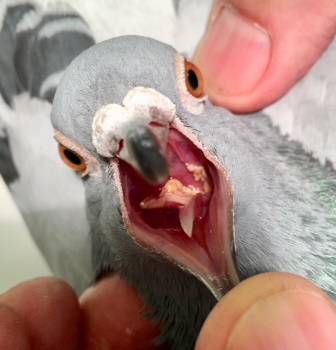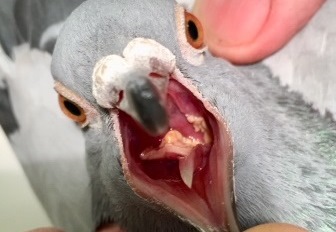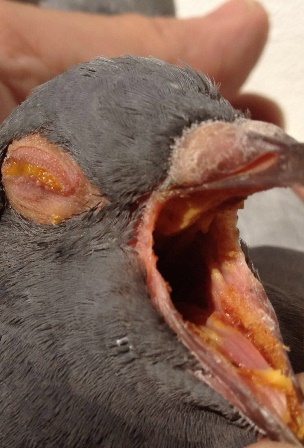

Misleading information about pigeon diseases on the internet
Misconception
The internet is a wonderful medium. You will find a wealth of information on just about everything via Google. But, in the case of pigeon diseases, ‘lay audience’ (writers and some veterinarians) put out incorrect or incomplete information about it, with all the trouble that entails!
After having written off several so-called ‘trendy disorders’ in the past 25 years, it’s now time for the misconception that the Herpes virus is a big problem!
But first back to some ‘trendy disorders’ from the past.
Streptococcal infection mythology
There was, among other things, the streptococcal infection mythology for the pigeons with wing problems at the beginning of the season and during the season. These were, and are, in more than 90% of all cases, injuries of the shoulder joint, so damage to cartilage, tendons and ligaments, in varying degrees.
It is comforting, when such a practical hypothesis from 25 years ago, done by myself, is confirmed by recently published German scientific research.
Wow, 25 years explaining to many clients in the Netherlands and abroad that streptococcus is rarely a problem with pigeons with wing problems was sometimes quite a task. Stubborn fanciers who simply did not want to believe that it wasn’t streptococcus! Of course, we also see pigeons with wing problems with paratyphus, but usually between September 15 and March 1.
Misconceptions about fungal infections
The same kind of misconceptions exist around fungal infections in pigeons. They are also very rare and hardly ever cause a problem for our pigeons. Of course, we can regularly detect fungal spores with swabs from the crop, but that is quite logical since pigeons often eat from the ground and a grain can quickly become mouldy. No problem then. It only becomes a problem when the crop is full of mould spores and there is also excretion through the droppings, and … when the pigeon is ‘sick’. Fungal infections are actually very rare in our pigeons!
Circoviruses hysteria
Although there had been some hysteria concerning circoviruses, even among some colleagues, I have never been alarmed. I simply didn’t see any ‘new’ symptoms when circoviruses suddenly became ‘hot’ about eight years ago. We could cure adeno-coli well and I simply could not understand the idea from scientific sources that the circovirus was the primary cause of the coli problem. And now I hear that a study at the University of Leipzig seriously questions the involvement of circovirus in ‘adeno-coli’. Bravo, another proof that good clinical diagnostics, once, often years later, are being confirmed in the laboratories of the universities.
Mispresentations about Herpesvirus infections
Misrepresentations about Herpesvirus infections
Another misconception, or sometimes even deception, is about Herpesvirus infections. These rarely play a significant role with old pigeons. There are a number of causes for the appearance of various types of yellow (stuck processes or loose ’tissues’) in the front, in the bottom, in the back, at the top of the beak, varying from Trichomoniasis to pox diptheria, from Herpes II (young pigeons) to yellow tissues after heavy flights in hot weather (blocked nasal passage). Candida also sometimes has yellowish-white lesions, but that is quite rare.
Herpes infections or Trichomoniasis?
We were consulted by several fanciers who thought their pigeons had a Herpes infection! Pigeons were dying, usually the youngsters in the nest, from about ten days old, but also older than 10 days. The parents of these pigeons sometimes had yellow ‘lumps’ in their beaks. Due to surfing on the internet, these fanciers thought of Herpes, but of course it was Trichomoniasis (see picture Trichomoniasis). Which can be treated quickly and effectively.
If you have ever seen herpes in young pigeons, you will never forget it again! I always call it type II. The affected youngsters, usually from 6 weeks old, all die within about 5 days. See photo Herpes II with youngsters.
Photo Herpes II with youngsters.
We never see this with old pigeons.

Photo Trichomoniasis.
Once they are at this stage, they cannot be treated. But luckily, we have discovered that the not yet visibly affected pigeons can be perfectly protected by means of a single injection with a specific antibiotic! We invented that trick about 35 years ago and it still works today!
Herpes is not a problem with older pigeons
More than 60% of all pigeons have antibodies against this because they are or were latently infected. They therefore have no symptoms! And if there is any suggestion that this Herpesvirus type I has something to do with ornithosis, then it is not understandable that you can cure this ornithosis complex with the right antibiotics (and we can), because viruses are insensitive to antibiotics. Ornithosis is the biggest problem for the condition and orientation abilities of our pigeons (old and young). And the primary cause is Chlamydia along with bacteria like Haemophilus, Mycoplasma, Staphylococci and some of the other bacteria.
At a F.C.I. congress in Brussels, a German colleague explained a study that was done on Jungtierkrankheit (‘Young Bird Disease’). They didn’t think adeno-coli a suitable name and they still don’t know why the disease breaks out so suddenly and so massively. They only had their information from after 1982, while we were already confronted with it in the seventies and had drawn our own conclusions!
There were about ten pigeon veterinarians from various European countries and a Polish professor! One of my German colleagues from the German pigeon clinic told me that in the autumn of 2015, she had regularly seen young pigeons with yellow lumps in their beaks, red mucous membranes, very sick and dying. She found Tricho and sometimes Candida, but she didn’t know how to deal with them! She told us that all these pigeons had been vaccinated against Herpes with a Slovakian combination vaccine.
I already suspected what the problem was, showed her the photo with Herpes II (earlier in this article) on my iPhone and told her what the diagnosis was.
Fortunately, this young pigeons-Herpes is rare, although I have seen an increase in recent years!
The moral of the story is that it is very important to know how often diseases actually occur! Is it 5%, 10%, 20%, etc.?
And you can’t learn that from the internet.
BELGICA DE WEERD B.V. I Postbus 4607 I 4803 EP Breda I Nederland
T +31 76 560 02 22 I F +31 76 565 35 70 I info@belgicadeweerd.com I www.belgicadeweerd.com


